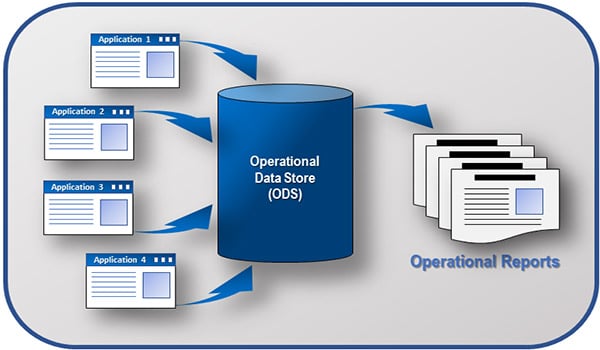In the data processing and analytics world, when it rains, it pours, mainly due to the massive amounts of insights that come streaming into your systems. To effectively gain the most relevant insights, different data models can be implemented depending on the task at hand.
One such data model is the Operational Data Store (ODS) which helps process data from multiple sources into one set of aggregated insights. Using ODS can bring many benefits to the organization you are managing but before implementing, here is a better understanding of its architecture.

Table of Contents
ODS Architecture Overview
An operational data store has a marvelous architecture that helps with its core task of providing the most relevant insights at that time. ODS replicated data from multiple sources, which could even be disparate collection systems. For example, it can pull data from a cloud-based solution and even from a physical data center. All of these insights, when collected, are replicated using the ETL system, which stands for Extract, Transform and Load.
Briefly, a well-designed ODS system will extract this data from multiple sources, transform it to a standardized format and load it on the intended application. As such, ODS helps simplify the task of collecting data from numerous sources and processing it. That can help organization leaders get a holistic snapshot of company operations or whatever data they were collecting depending on their objective.
Temporary data storage location
The architecture of an ODS does not allow this system to store data for the long haul. Instead, it is designed to be a temporary data storage location that focuses on data currently under operation. This data model architecture is not suitable for archiving and calling historical data because it gets overwritten as time goes on.
Having the temporary data storage location capabilities only does not limit the functionalities of an ODS. On the contrary, it helps meet the objectives of this sort of data model because it focuses on the most relevant operational data, making it suitable for tactical decisions that need to be made on the spot. Also, a side benefit of ODS systems being temporary data storage locations is the expediency of processing and loading relevant insights.
Integration capabilities
Depending on the objective of the organization, there are several integrations that can be made to an ODS system. Each use case might have varying requirements and the flexibility of ODS systems helps facilitate custom-built solutions. As the concept of technology influencing businesses continues to be normalized, having operational data on hand is essential. To facilitate that, you have the option of integrating an ODS system directly into your BI tool to power an operational data-based dashboard.
Alternatively, you can integrate the ODS with a data warehouse to archive and store the data to be accessed again in the future. The architecture of this data system is flexible to either type of integration with the target application. Therefore, when you design your system, take into consideration the objective of factoring ODS and the length of which you’ll need the data.
Using ODS in conjunction with a data warehouse
When implementing ODS systems in conjunction with a data warehouse, there is also more involved to this. However, the objective of using this system setup is to access data for future references. The data could also be queried by the end-users, such as customers instead of administrators only. Therefore, you can use ODS systems in conjunction with a data warehouse when customers or your system will need a record of insights.
You can use this integration to power BI tools for generating historical reports, which require an accurate data record. To reach the intended audience, you can use APIs or data marts to extract the data from the warehouse. However, the data will have been aggregated from multiple sources, which could have been very challenging to do without the ODS tier.
Using ODS architecture effectively
Just like any other system out there, ODS can be misused, underused or overused and that is why using it effectively is pivotal to reaching the set objectives. How can you effectively use the ODS data model architecture? First of all, conducting a task inventory of the tasks that need to be completed using the system is important. This will help figure out the appropriate integrations to make and whether or not to add certain data access layers.
As a result, you might recognize that some data access layers or integrations are not really necessary and would just slow down the system. Additionally, assessing the data sources will also determine whether an ODS is necessary or not. For example, if there is only one data source, there is no need for an ODS because it aggregates insights from multiple sources.
ODS architecture use cases
ODS can be used in a wide variety of applications that could be intended for internal operations or servicing customers. Whatever the objective may be, you can effectively use ODS architecture either directly or as a data access layer. A prime example of using ODS is storing transactional data for customers in an e-commerce platform.
As the customer is making a purchase, their data is stored on an ODS as it is currently operational insights. However, to have a record of transactions for that customer, the data might need to be passed to a data warehouse for future references. The same applies in the BI field; there might be operational information that needs to be processed using ODS. In the long run, that data might need to be stored in a warehouse for reporting within a set period of time.
Closing thoughts
ODS systems are the best kind of system to process operational data that powers tactical decision-making on the fly. At the same time, it serves as an awesome tier that aggregates data and then passes it on to a data warehouse. You can implement the ODS architecture in any of these ways to meet the objectives set for the company.